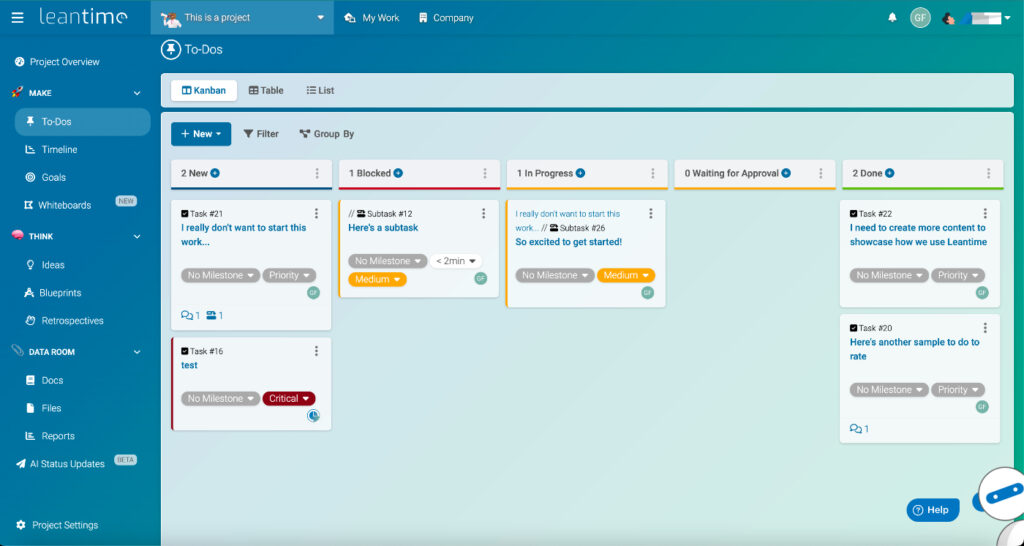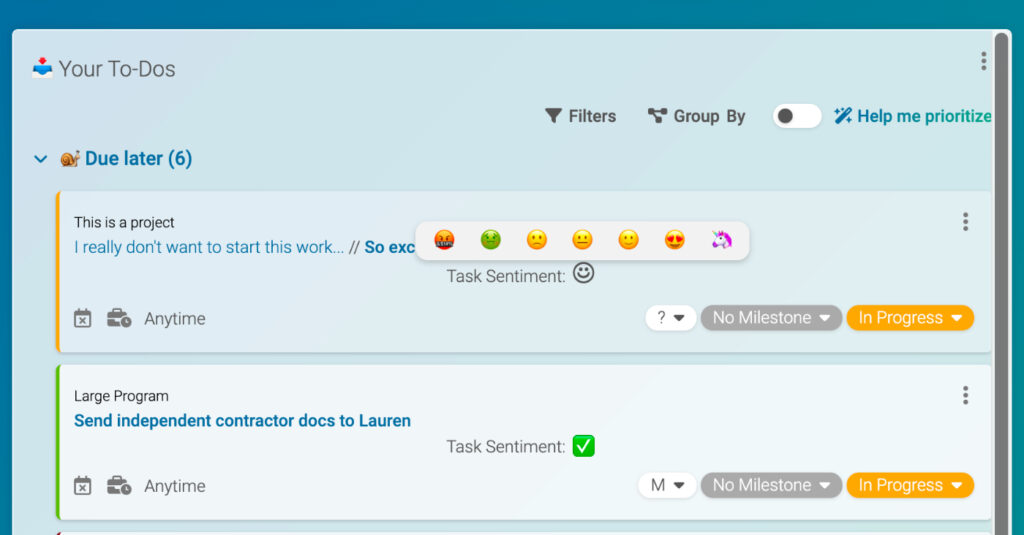Estimated reading time: 11 minutes
Attention Deficit Hyperactivity Disorder presents unique challenges for project managers and yet, surprisingly to some, people with ADHD are often attracted to project management. Having ADHD as a project manager is a double-edged sword, so to speak.
Where the challenges often impact one’s ability to stay organized, focused, and productive and yet the benefits of having ADHD as a project manager include the ability to multitask, identify creative and out-of-the-box solutions, and be less risk averse.
Table of contents
Fortunately, there are tools that can both amplify the value ADHD brings and improve on the challenges that it brings. One such tool is the Kanban method, which utilizes visual organization to improve focus and quickly communicate status to everyone involved.
The ADHD Project Manager’s Struggle
While project management is a great field for someone with ADHD, it will still come with its own unique obstacles. Project managers with ADHD face unique challenges affecting their ability to manage tasks effectively.
Many of us with ADHD make great project managers because we are experienced in getting organized to survive in the world.
ADHD symptoms, such as inattention, impulsivity, and hyperactivity, can impact productivity, focus, and organization, making it difficult to keep projects on track and meet deadlines and to stay up on tasks throughout the day.
Did You Know: According to a 2020 survey, only 35% of project managers were satisfied with their project management tool.
One of the biggest challenges and the things I struggle with the most is to keep track of the little tasks that come up but are not tasks at a project level. As a result, there is a growing need for tailored solutions and resources that specifically address the challenges faced by managers with ADHD.
Navigating the Distinct Challenges of Project Management with ADHD
ADHD symptoms can manifest in various ways, such as struggling with prioritization, difficulty staying on task, and managing multiple projects simultaneously.
For myself, I find my hyperactivity is often in my brain and I can find myself quickly overwhelmed if I don’t have a strong process to keep things controlled.
Read More: Running a Business with ADHD
As a result, these challenges can lead to missed deadlines, incomplete tasks, and a higher risk of project failure. Recognizing these unique obstacles is the first step toward finding effective solutions.
Impact on Productivity, Focus, and Organization
Productivity and focus can become disrupted when I find my brain bored in a meeting, or when I’m not engaged in a project but still have to stay up to date on it. I’ve seen this most impacted when I’m lost in thought and someone calls on me to answer a question and I don’t even hear it.
More than this, though, this disruption occurs more in an office when there are people everywhere, loud noises, conversations and interruptions that happen when I’m hyper-focused.
Read More: Getting Diagnosed with ADHD as an Adult: What Now?
Hyperactivity, whether shown in more impulsive behavior or in brain overload, can also disrupt staying organized and maintaining a structured workflow. These symptoms can collectively hinder a person or project manager’s ability to successfully manage projects and meet goals.
The Importance of Solutions Tailored for the ADHD Mind
Given the unique obstacles faced by project managers with ADHD, it is essential to find tailored solutions that specifically address their needs. These solutions should not only help manage ADHD symptoms but also enhance the project manager’s overall ability to manage projects effectively.
Implementing tailored solutions, can unlock the creativity of their own team and full potential and successfully navigate the world of project management.

The Power of Visual Organization with Kanban
The Kanban method offers a unique and way to visually organize tasks and their statuses. With its origins in manufacturing, it gained popularity as a tool to streamline work.
Creating a visual way to organize tasks improves communication, clarity, and when maintained, makes it easy to stay on top of when things are due.
Fundamentals of the Kanban Method
Kanban is a project management technique that focuses on visualizing work items and their progress through a workflow. The method uses a Kanban board, a tool that visually represents tasks as cards on columns or lanes, each showing a stage of the completed workflow.
This straightforward and efficient system facilitates effortless progress monitoring and bottleneck identification. The right tool for managers, software developers, or any other employees.
Visual Organization Supporting ADHD’s Unique Strengths
Visual organization plays a significant role in helping people with ADHD stay focused and manage their tasks more effectively. The Kanban board provides a clear and accessible way to view tasks, deadlines, and progress, allowing those with ADHD to easily prioritize their work and by staying focused.
Providing a constant visual reminder of smaller tasks helps project managers with ADHD better handle their symptoms and enhance their overall productivity.
Did you know: According to the International Dyslexia Association, as much as 30% of people with dyslexia will also have ADHD.
Visual Cues and Improved Focus
For people struggling with dyslexia and also with Attention Deficit Hyperactivity Disorder, visual cues are essential in creating the ability to quickly understand content.
In fact, dyslexia often co-occurs with ADHD and whether due to processing challenges or due to the hyperactive need to move quickly, creating a visual way to understand the tasks at hand make staying on track and organized easier.
This visual representation of tasks also aids the project team in maintaining focus on the end goal of the current task at hand, reducing distractions and improving the project manager’s ability to stay on track.
By leveraging the power of visual organization provided by the Kanban method, project managers with ADHD can overcome common challenges and excel in their roles.

Leantime: A Work Management System for ADHD
It’s essential to find a tool that supports ADHD in a place where it matters the most. Organization tools for ADHD are often focused primarily on individual organization and fail to incorporate projects and work or business related tasks.
As a result, people have to duplicate tasks in multiple locations in order to get organized. For someone with ADHD, this is a nightmare of an ask (from experience). The more places I need to put something, the more likely I will not continue to work with it.
As project managers with ADHD seek tailored solutions to support their challenges while enhancing their value, Leantime emerges as a unique project management tool designed specifically for people with ADHD.
This section will introduce Leantime, explore its features that cater to project managers with Attention Deficit Hyperactivity Disorder, and discuss the system’s flexibility and adaptability in managing projects in dynamic work environments, making sure everyone is on the same page.
Introducing Leantime
Leantime is a work management system created with a focus on inclusivity, catering to people with ADHD, ADD, and dyslexia. The software offers a wide range of features designed to boost dopamine and intrinsic motivation and a research-based design for easy reading.
Leantime caters to various work styles, making it suitable for small business owners, product teams, and digital consulting agencies alike.
Additional Features for Project Managers with ADHD
Leantime offers a suite of features that make it particularly suitable for project managers with ADHD. The software provides a visual representation of tasks through Kanban boards, aiding in prioritization and focus.

Being founded by someone with Attention Deficit Hyperactivity Disorder, Leantime is focused on incorporating science-driven features that support ADHD. These features include things like time blocking, an individual organization view, new ways to visualize the work, and being focused on goals.
The founders see a world where work is more personalized and relevant and where we can see how our work makes progress happen.

Other ADHD-friendly features include AI-based task prioritization, AI story time, AI status updates and reports, and an AI coach that provides variable rewards for completing tasks. These features not only help project managers with ADHD manage their symptoms but also enhance their overall ability to manage projects effectively.
Simplicity and Ease of Use to Stay Focused
One of the key strengths of Leantime lies in its simplicity and ease of use.
When tools are complex or overwhelming, they either become harder to adopt or the art of setting them up becomes the source of dopamine. Once it’s finished, the dopamine is gone or it never started.
Leantime establishes a workflow that you don’t have to dream up to use. In less than 10 minutes, you can be in the system and running a project.
This is not only beneficial to folks with ADHD but also to those who simply don’t enjoy project management tools or find them difficult to use.
Read More: The Best Open-Source Team Project Management Tools to Boost Team Productivity
Benefits of Combining Kanban and Leantime for ADHD

The benefits of combining Kanban and Leantime for individuals with ADHD are numerous as previously mentioned in this article. By implementing a Kanban board within the Leantime system, project managers can better prioritize tasks, maintain focus on their work, and ultimately improve their overall productivity.
Testimonials and Success Stories
Many project managers with ADHD have found success in combining Kanban and Leantime. Their testimonials highlight the positive impact of these tailored solutions on their productivity, concentration, and organization.
One project manager shared,
“Since implementing Kanban with Leantime, I’ve seen a significant improvement in my ability to stay on top of tasks and meet project deadlines. The visual organization and tailored features have made a world of difference in managing my ADHD symptoms and overall project management success.”
Tips for Success
No matter how long you’ve had ADHD, these challenges can make it hard to utilize tools like this. Being mindful of this and taking the time to implement additional strategies will help make the most out of the experience.
To make the most out of using Leantime and the Kanban or other Kanban tools, consider the following practical tips and strategies:
The Struggle to Maintain Consistency
Consistency is both essential and one of the hardest things for project managers with ADHD. I often think of the fact that in life, even for myself, I struggle to build habits and have to focus on building routines instead.
Creating routines helps put my brain on an autopilot of “When y happens, I do x,” and this pattern gets hard to break. This may require pairing the activity with another activity, such as end-of-the-day emails or first-thing-in-the-morning updates with my cup of coffee.
Establishing a routine for using Leantime and the Kanban board ensures that tasks are regularly updated and progress tracked. By maintaining consistency, project managers can better manage their ADHD symptoms, set deadlines, and stay on top of their work.
Continuous Adaptation and Learning
Adaptation and learning are key components of success for project managers with ADHD. It helps support the drive for novelty and newness. By continuously evaluating your workflow, identify areas for improvement, and incorporate new strategies or the right tools as needed.
By embracing continuous adaptation and learning, people with ADHD can ensure they are making the most of Kanban and Leantime, ultimately resulting in more effective project management.
Project managers and people with ADHD can greatly benefit from implementing Kanban with Leantime. By following these practical tips and strategies, they can better manage their unique challenges and succeed in their project management roles. Embrace tailored solutions like Kanban and Leantime to unlock your full potential.
Conclusion
We’ve explored the unique difficulties faced by project managers and the potential benefits of understanding and implementing the Kanban method within the Leantime work management system.
We have explored how the visual layout of Kanban boards can assist individuals with ADHD in enhancing job focus and prioritization, as well as the customized features and adaptability provided by Leantime.
Additionally, we delved into the personal experiences of project managers who have successfully implemented Kanban with Leantime and offered practical tips for overcoming common difficulties and maintaining career success in project management roles.
Managing ADHD in a project management role is possible with the right project planning, management tools, and structured approach. Project managers are encouraged to explore and embrace tailored solutions like Kanban and Leantime to help them navigate the complexities of their work and unlock their full potential in planning and managing projects effectively.



